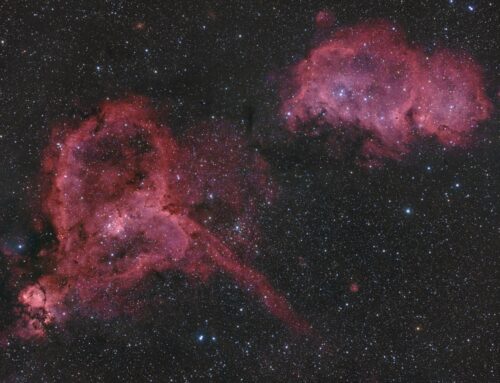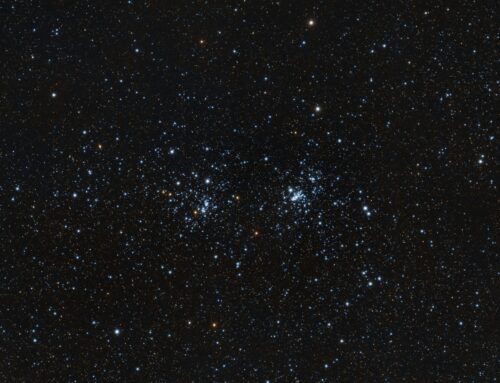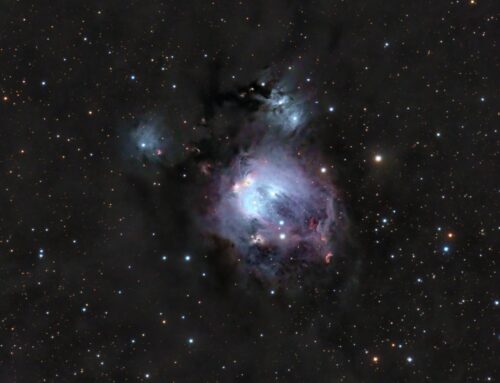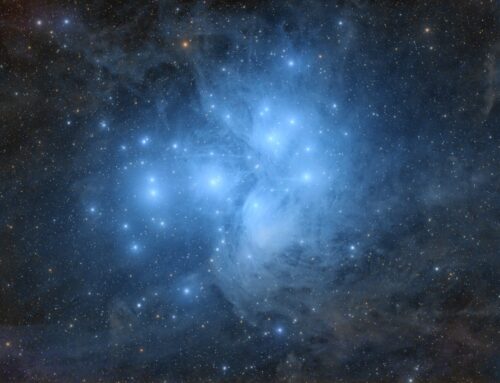Comet PANSTARRS C/2017 T2 and the Double Cluster
 Click image for full size version
Click image for full size version
February 5, 2020
In the lower left quadrant of the image is a solar system interloper, Comet PANSTARRS C/2017 T2. As of February 5, 2020 it is about 250 million kilometers from Earth, recently having passed its closest approach, and is now receding. It is no longer visible in binoculars, but is still easy to find in a moderately large telescope in a dark sky. If you missed it on this go-around, you can see it on its next pass in about half a billion years.
In the centre of the frame providing a backdrop for Comet PANSTARRS is the Double Cluster includes NGC 869 (left) and NGC 884 (known as h- and Chi-Pereus, respectively), each comprising hundreds of stars. Both are about 13 million years old (compared to 75-150 million years for the Pleiades). They lie about 7,500 light years away and a few hundred light years apart, and have a combined mass of about 6,500 times the mass of our Sun. However, the clusters have a halo totalling more than 20,000 solar masses and each contains more than 300 blue giant stars. The clusters are moving towards us at a speed of about 40 km/s.
These clusters were bright enough to get star designations, and are both visible to the naked eye as foggy patches in a dark sky not far below the “left” side of the “W” of Cassiopeia in an autumn sky. Some people refer to them as the handle of Perseus’ sword. This pair is gorgeous in binoculars of any size, having the appearance of salt sprinkled in two little glistening piles on a black tablecloth. In a small telescope the view is wonderful. Large telescopes reveal more stars, but tend to have a field too small to show the pair together. My current setup gives a very wide field view that includes a couple of overlooked objects: open cluster NGC 957 is on the right side of the field below centre, and dark nebula B201 is the relatively star-free triangle-shaped region to the left of the Double Cluster.
If you’re interested in seeing the Double Cluster more up-close and personal, see my image from 2015 taken with a 10″ reflector.
Tekkies:
Takahashi FSQ-106 ED IV @ f/3.6, QHY367C one-shot colour camera, and Optolong L-Pro filter, Paramount MX, unguided. Acquisition, and focusing with TheSkyX. Focus with Optec DirectSync motor and controller. Automation with CCDCommander. Equipment control with PrimaLuce Labs Eagle 3 Pro computer. All pre-processing and processing in PixInsight. Acquired from my SkyShed in Guelph. Half-moon, average transparency and poor seeing. Data acquired around 1 am UTC on February 4, 2020.
6x5m with Optolong L-Pro filter (Total = 30m)
Image scale 2.6 arcsec per pixel
Data Reduction and Processing
Preprocessing: The WeightedBatchPreProcessing script was used to create a master frame.
Channel Registration: To improve channel registration, the RGB colour channels were extracted and aligned with StarAlignment, using Thin Plate Splines with Distortion Correction and the green channel as the reference frame. The registered colour channels were recombined with ChannelCombination.
Gradient Removal: DBE was applied using Subtraction to remove the minimal gradient that remained after integration.
Colour Balancing: The colour image was colour balanced with ColorCalibration.
Linear Noise Reduction: MultiscaleLinearTransform was used to reduce noise in the background areas, using an internal mask to protect bright structures. Layer settings for threshold and strength: Layer 1: 5.0 0.85, 2 iterations; Layer 2: 3.5, 0.75, 2 iterations; Layer 3: 3.0, 0.5, 1 iteration; Layer 4: 1.0, 0.25, 1 iteration.
Stretching: HistogramTransformation was applied to make a pleasing, bright image, with background set to an intensity of approximately 0.10.
Nonlinear Noise Reduction: TGVDenoise was used in L*a*b* mode to reduce noise with a mask used to target the background areas and protect the stars (max. 1000 iterations and convergence selected for both lightness and chrominance).
Final Steps: Background, nebula and star brightness, contrast, colour saturation were adjusted in several iterations using CurvesTransformation with masks as required. ICCProfileTransformation (sRGB IEC61966-2.1; Relative Colorimetric with black point compensation) was applied prior to saving as a jpg.






Leave A Comment